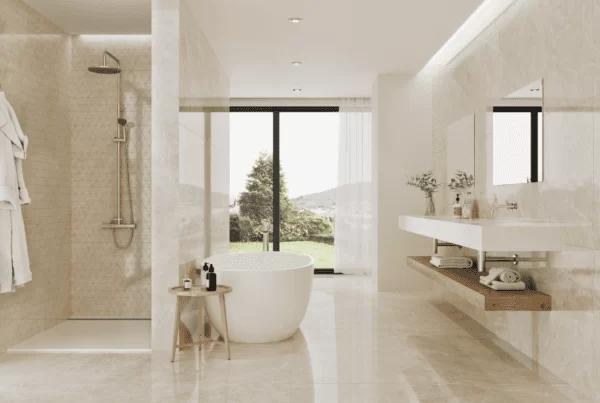Differences between the different types of glazed porcelain tiles
Porcelain is a very popular tile to use these days, and it is used in many different applications, such as flooring, decorative tiling, wall cladding, work surfaces, dining & coffee tables, patio covering, driveway designing, and many more such functionalities. This is due to the fact that porcelain is a very practical kind of tile, whereby it is relatively inexpensive, light (and so it is easy to transport and install) and it comes in a very wide range of different colours, patterns, finishes, sizes, textures and much more variety. Therefore, porcelain will be able to fulfil most requirements of people, and that is why it is such a popular choice amongst the customers in the market these days.
Porcelain vs Ceramics
Porcelain originated from ceramic tiles, which were very popular previously, and ceramics can still be found in very traditional and Victorian styled homes. However, porcelain is made out of better raw material ingredients (such as refined white clay, feldspar, silica, sand, and much more), and it is fired at significantly higher temperatures, under much more pressure, and so porcelain has become more durable in a general sense. Furthermore, porcelain can achieve much smoother textures and much more glamorous looking designs and patterns.
Unglazed porcelain tiles
Porcelain can come as unglazed, and these split themselves into two main groups, the full bodied porcelain tiles and the double loaded ones. Full bodied porcelain tiles are simply when various metal oxides, minerals, pigments, and such materials are added to the clay mould before it is fired in the kiln to form the porcelain, and so they create different colours, patterns, or designs within the tiles, and these run all the way through the tile. However, some colours require certain relatively expensive materials to be created, and they are in demand in the market. Therefore, manufacturers tend to use these kinds of colours in double loaded porcelain tiles. When manufacturing these tiles, manufacturers use an especially strong template to press the porcelain mix against, before properly moulding and firing in the kiln. The template consequently forms recessive sections and inclines, so that once the tile has been fired and completed the cooling period, these spaces can be filled with the liquidised minerals and metals that will create a beautiful pattern and add some stunning colours to the tile, in order to make the final product look magnificent, but still have a natural look to it.
Types of glazed porcelain
Glazed porcelain can come in many different kinds, the main three categories being polished, lappato (also known as semi-polished), and matt. Glazed tiles have a liquidised glass or an enamel layer smoothly rolled onto the tile to create a lovely design of a digital stone print, and they can create either a gloss effect or a matt effect, and this means that all matt tiles have been glazed as well, and it is a misconception to think that the matt porcelain tiles are not glazed.
Materials used for glazing
Silica is the main and most common ingredient used in the glazing of tiles. In simple terms, silica is industrial sand, which can be found and extracted from a wide variety of different sources, such as sandstone, natural sand, flint and many more. It may also however be manufactured as Silica Oxide. In addition to the Silica, manufacturers also add fluxes and other raw materials in small quantities to the mix, and this is in order to reduce the melting point of the whole mix, because Silica forms the main contents of the glaze, but alone it would need to reach around 1,700 degrees Celsius before it melts, which is a temperature that is too high for any sort of porcelain and ceramics kiln. The most frequently used fluxes used within the glazing of the tiles in the industry are Calcium Oxides, obtained mainly from limestone, such as Potash feldspar and soda feldspar.
Alumina is another essential ingredient in making a porcelain glaze. Alumina helps in dispersing any gas bubbles that may form during the firing stage of the glaze, as to leave a beautiful smooth surface. Even more importantly, Alumina is the stiffening agent within a glaze mixture, and so without this material, the glaze would simply slide off any tile that it is coated onto, so Alumina ensures that the glaze sticks tightly to the tile. Aluminium is either added to the mixture in the form of clay (kaolin being the main type) or added as Alumina hydrate, which is a white synthetic powder.
Metallic oxides, mainly being Calcium Oxide as we mentioned, are used in order to lower the melting point of the mixture in order to ease the process of glazing tiles and make it more cost effective, however some other metal oxides such as Cobalt Oxide, Magnesium Dioxide, Titanium Dioxide, Iron Oxide and some others can also be used as pigments within the glazing coat. Therefore, manufacturers tend to make many different mixtures of tile glazes, each of a certain colour, and use a special computer programmed machine to print out the digital replica of a natural stone pattern onto the tile. In addition to the colouring agents, some other materials may be added sometimes to alter the opacity and the shine of the glaze as well.
Features of the different types of porcelain tile glazes
Polished tiles are very attractive, as they reflect light and so they create a very airy atmosphere, and even though the layer of glaze is quite slip resistant, in order to achieve the gloss effect, the glaze must be ground with large stones once it is settled onto the tile, and so polished tiles become relatively slippery under wet conditions. In order to counteract that, lappato finished tiles have a beautiful semi-glossy finish to them, but they are matt, as they are ground using small stones only, and so they create quite an anti-slip surface, to be used in bathrooms and kitchens. However, if you need to tile a wet room, then the semi polish of the lappato will still not be enough to prevent you from being sent flying, and so if you do not want an unglazed tile, then the matt finished glazed tiles fulfil that role perfectly as well, as they have small texture, and their glazes are not ground at all, and so they are very anti-slip, making them especially suitable for outdoor use as well.



